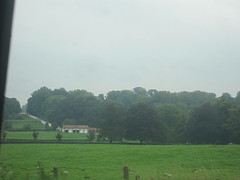
Moving to a new country with different customs, values and language, will cause you to experience culture shock. We went through it. Our friends went through it. It’s normal, so try not to freak out too much (even though meltdowns are inevitable) and don’t worry, it will get better. The crazy part is that once you’ve successfully adapted, the odds are that you will return to your native culture and experience the same thing (known as reverse culture shock).
Dictionary.com defines it as “a state of bewilderment and distress experienced by an individual who is suddenly exposed to a new, strange or foreign social and cultural environment.” Everyone’s different and everyone’s experiences are different, but there is a common pattern. People experiencing culture shock generally go through these stages. It starts with the ‘Honeymoon Phase.’ This is the “oh, how charming” stage. You will find everything is an exciting and interesting. It seems like you are on vacation. Who ever vacations someplace long enough to get sick of it (‘Paris Syndrome,’ ‘Jerusalem Syndrome‘ and ‘Stendhal Syndrome‘ excluded)?
How much you put yourself out into the other culture, how insulated you are from it and the pressures you experience will help determine its length, but generally it this phases lasts a few days to a few weeks. Obviously, the more you mix it up with the local culture, the quicker it will end. Don’t worry though, the loss of this euphoria should ultimately lead you to better understanding of the culture and adaptation.
There’s no way to sugarcoat this, what happens next distressing, you will probably drop an expletive (in your native language since you probably don’t understand too much of the local one) and realize you have changed almost everything in your daily life. While this may arrive in a time of peace (and induce panic), it is much more likely that you have just locked yourself out or had some other bad experience. This is called the ‘Negotiation Phase.’
Just like that, the honeymoon/vacation is over and you have to start living your daily life someplace where you don’t know how to do it. Between us, we felt disoriented, confused and lonely. After trying to get the apartment set up and start work, we were exhausted. Having been though it I fought the urge to speak in English and succeeded some of the time. Other people, watch their American shows on sling boxes, hunger for food from the US (even if it is McDonald’s and they don’t even like fast food) or spend their time with other expats. Essentially, you become nostalgic for your native culture (while forgetting its problems).
Instead of getting better, things only get worse (or at least they do until they get better). Living somewhere where you don’t understand how things works is disorienting. You get sick of feeling incompetent (see Les Incompetents posts). You wonder how you went from someone who was competent to, well, this. Plus, with your support systems far away and your new ones not well established, it can be even harder. It’s easy to focus on the negative. Even if you don’t, you’re likely experiencing many more negative emotions than usual. Anger? Check. Sadness? Check. Frustration? Impatience? Dissatisfaction? Depression? Aggression? Rage? Check. Check. Check. Check. Check. And, um, yep, check.
If this is you, remind yourself that this is inevitable when adapting to a new and different culture. It’s at this time that most people want to leave. Others get really depressed or negative. Try like hell to keep a positive and open attitude. It will be hard to connect with people if you seem like a loose cannon. I know that life is a minefield of potential problems and you will completely screw up the simplest things (that you used to do without thinking in your native country).
Trust me when I tell you people may try to help, but 99% of them don’t understand what you are going through. Trust me also when I tell you that lots of others of them flat-out don’t care. I know it sounds bleak and you are probably asking why would anyone ever do this. Remind yourself that you are in the middle of the ‘Adjustment Phase.’ Trust me one more time when I tell you that it will get better and it is worth it. I repeat. It will get better and it is more than worth it.
If you work hard to learn the culture, accept the customs, adjust and integrate, at some point things will get better (usually from six to nine months). You will acquire a critical mass of knowledge, reach an inflection point and things will get easier. You will start to feel like less of an idiot all the time. Heck, you might even feel competent. Even if you still don’t understand everything, daily tasks won’t induce the same level of anxiety. It makes your life a lot easier and enables you to have a more balanced view of your new culture. You will get happier and people tend to respond positively to this. You’ll still probably make a fool of yourself (see Les Incompetents posts), but it won’t be as often.
Finally, you will enter the ‘Mastery Phase.’ It’s enriching and rewarding. It builds your confidence and increases your understanding of the world. You better understand and appreciate your native culture (or aspects of it anyway). You will grow in ways you never imagined. You have made amazing friends. Some continue even further break through to an even deeper and richer understanding of your new culture.
Culture shock isn’t the easiest thing in the world to deal with, but since when do you get something for nothing? It’s the price you pay for the wonderful experiences, knowledge, growth and friends.
This post is for one special person who rocks. Hang in there.












































